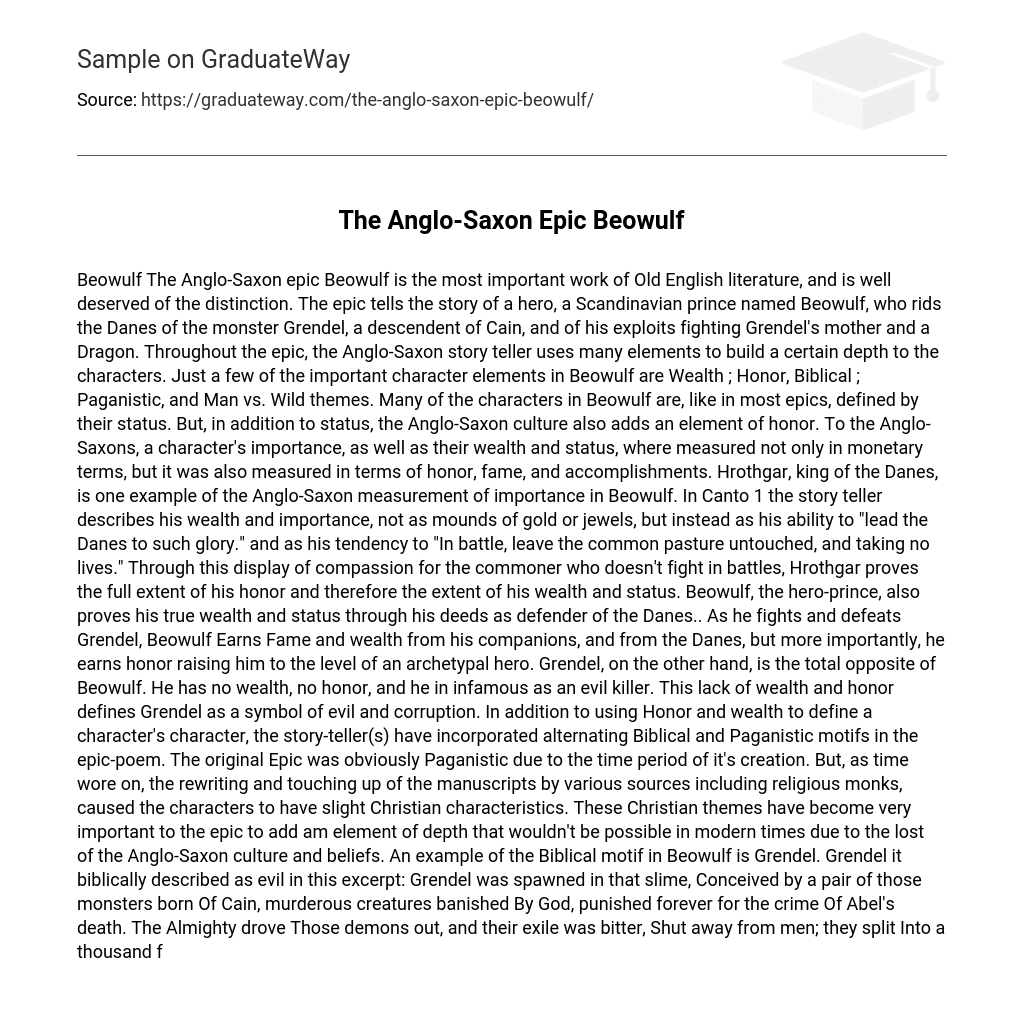Beowulf, the Anglo-Saxon epic is the most significant piece of Old English literature and it truly deserves its distinction.
The narrative recounts the tale of Beowulf, a royal figure hailing from Scandinavia, who liberates the Danes from the monstrous Grendel, a descendent of Cain. Furthermore, it depicts his heroic endeavors against Grendel’s mother and a Dragon. Throughout the saga, the Anglo-Saxon storyteller skillfully employs various elements to craft a profound characterization. Beowulf encompasses significant themes such as Wealth, Honor (both Biblical and Paganistic), as well as the clash between Man and Nature. Similar to many epics, the characters in Beowulf are primarily defined by their societal standing. However, the Anglo-Saxon culture equally emphasizes the notion of honor.
To the Anglo-Saxons, a character’s importance, wealth, and status were not only measured in monetary terms, but also in terms of honor, fame, and accomplishments. Hrothgar, the king of the Danes in Beowulf, exemplifies this Anglo-Saxon measurement of importance. In Canto 1, the story teller portrays his wealth and importance not as vast amounts of gold or jewels, but rather as his ability to “lead the Danes to such glory” and his tendency to spare the common people in battle. This display of compassion for non-combatants not only showcases Hrothgar’s honor, but also signifies the extent of his wealth and status. Similarly, Beowulf, the hero-prince, establishes his true wealth and status through his actions as the defender of the Danes. By defeating Grendel, Beowulf earns fame and wealth from his companions and the Danes. However, more importantly, he earns honor which elevates him to the status of an archetypal hero. Conversely, Grendel represents everything that is opposite to Beowulf.
Grendel lacks wealth, honor, and is infamous as an evil killer. This absence of wealth and honor makes Grendel a symbol of evil and corruption. The story-teller(s) also incorporate alternating Biblical and Paganistic motifs in the epic-poem to define the characters. Originally, the epic was Paganistic because of its creation during that time period. However, over time, religious monks rewrote and edited the manuscripts, giving the characters Christian characteristics. These Christian themes greatly contribute to the depth of the epic, which would not be possible in modern times due to the loss of Anglo-Saxon culture and beliefs.
The motif of the Bible can be seen in Beowulf through the character of Grendel. In the excerpt, Grendel is depicted as evil and linked to biblical references: “Grendel was spawned in that slime, Conceived by a pair of those monsters born Of Cain, murderous creatures banished By God, punished forever for the crime Of Abel’s death.” These demons were driven out by the Almighty and condemned to exile, forever opposing the will of the Lord. The presence of this biblical reference in the epic has evolved into an archetypal motif in modern times. It conveys the pure evil and justifies Grendel’s murderous behavior, while also revealing the torment he feels due to his banishment from God. This understanding offers insight into why Grendel would target the Danes out of envy for their happiness.
Beowulf possesses a religious aspect to his character, as demonstrated by various instances in the text. For instance, in Canto 6 line 381, Hrothgar indicates, “Our Holy Father had sent Beowulf as a sign of His grace, a mark of His favor, to help us defeat Grendel and end that terror.” This religious portrayal presents Beowulf as a kind of messiah who has been sent by God to rescue mankind from evil. Furthermore, this depiction also highlights the goodness within Beowulf’s heart and the purpose behind his mission, despite his lack of messianic status. Another parallel to biblical references in Beowulf is the tower of Herot, which shares similarities with the tower of Babel. Both structures are constructed as symbols of superiority and accomplishment.
Herot, similar to Babel, functions primarily as a representation of decline rather than distinction due to its associations with numerous fatalities and the arrival of Grendel. Alongside themes of Wealth, Honor, and the juxtaposition of Paganistic and Biblical elements, the portrayal of character is also manifested through a Man vs. Wild motif, illustrating the contrast between humanity’s virtuous ways and the savage nature of evil.
The character Grendel is depicted as evil due to his wild and untamed nature. The description of his home as a “hell not hell but earth” further emphasizes his primitive and evil qualities. In contrast, Beowulf represents mankind’s civilized and virtuous ways. He is portrayed as tame, civilized, and the embodiment of goodness and purity.
Beowulf demonstrates a different approach to fighting evil, as seen in his initial battle against Grendel. Instead of resorting to wild tactics, Beowulf displays purity by removing his armor and vowing to face Grendel without a weapon. His triumph over Grendel proves that even without armor and weapons, humans can overcome evil in any form, including formidable foes like Grendel. This act serves as a recurring symbol throughout the epic, showcasing Beowulf’s inherent goodness. Additionally, Beowulf encompasses various other archetypal, symbolic themes and motifs, but the wealth, honor, religious, man, and wildness themes stand out as the most significant elements that enhance the complexity of the characters.
These themes not only define a character, but also serve as a motive for their actions.





